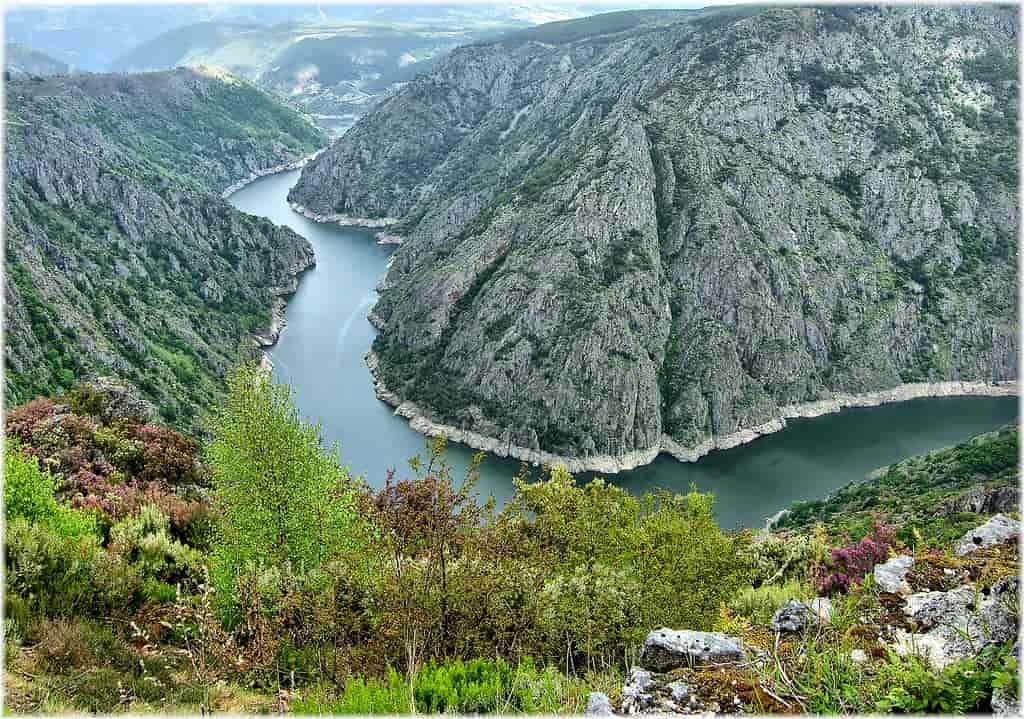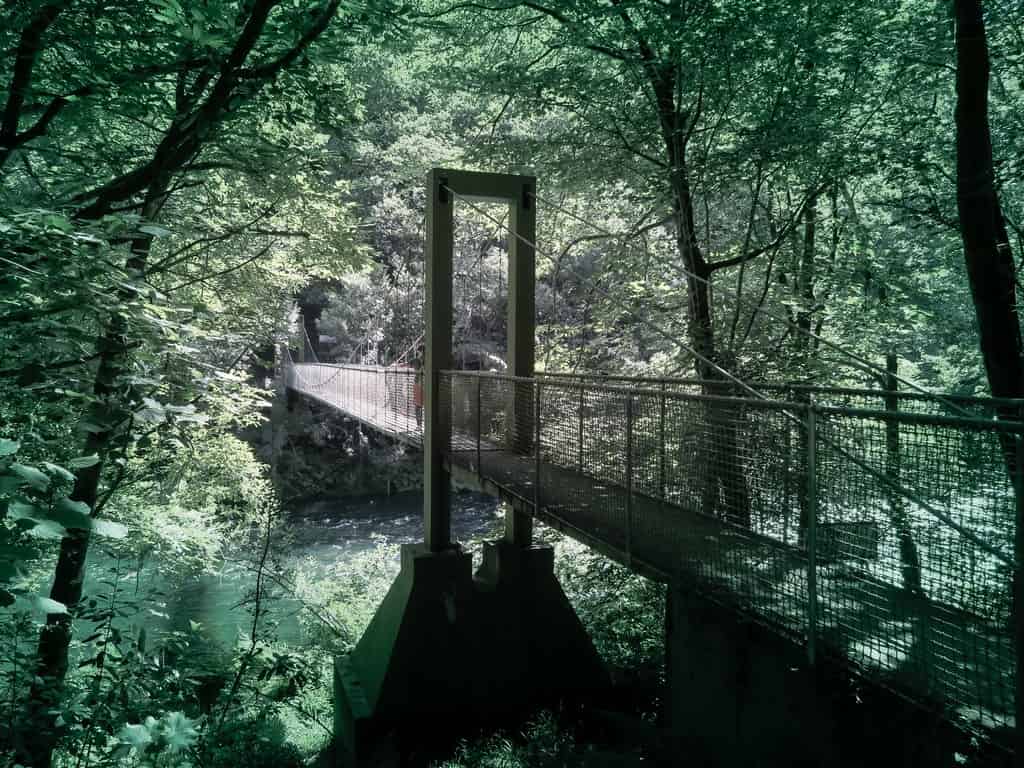
The Camino de Santiago is a unique experience, but once you reach the Plaza del Obradoiro, you may still feel the desire to continue exploring Galicia. The region offers a wide variety of hiking routes that allow you to discover spectacular landscapes, from mountains to rugged coastlines.
If you’re looking to extend your adventure on foot, here are seven options that will allow you to enjoy nature with the tranquillity that characterises this land.
Índice de contenidos
- 1 The Ruta Dos Faros: Coastal hiking with an Atlantic essence
- 2 The Ribeira Sacra Route: Vineyards and river canyons
- 3 The Fragas do Eume Natural Park: An ancient forest
- 4 The Santo André de Teixido Trail: A path with tradition
- 5 The route of Mount Pindo and the Ézaro Waterfall: Granite landscapes and sea
- 6 The route from the Albergue to Tres Bispos in Os Ancares
- 7 The Loiba Cliffs Route: Wild nature on the Galician coast
The Ruta Dos Faros: Coastal hiking with an Atlantic essence
If after the Camino you want to keep exploring Galicia on foot, the Ruta dos Faros is an excellent option. This 200-kilometre route connects Malpica with Fisterra, following the line of the Costa da Morte. Along the way, you will walk between cliffs, wild beaches, and landscapes of great natural beauty.
Many pilgrims choose to walk this route with the help of a Caminho de Santiago agency, as the logistics can be complex in some sections. Although the entire route can take up to a week, there are options to do just a few stages. Each day offers unique views, with historic lighthouses such as Punta Nariga or Cabo Vilán marking the way.
- Distance: 200 km (you can walk stages of 20-30 km)
- Difficulty: high (long route, exposed to the weather, and with elevation changes).
The Ribeira Sacra Route: Vineyards and river canyons

If you prefer an inland setting, the Ribeira Sacra is an ideal destination. This region is famous for its terraced vineyards and the impressive Sil River canyons. There are multiple hiking routes that allow you to explore its landscapes, such as the Cañón del Sil route or the Senda de los Monasterios.
This destination is especially appealing to those who want to have an adventure before starting the Camino Sanabrés from Ourense, as it is located not far from this starting point.
Any of these routes will allow you to discover a different side of Galicia, with spectacular viewpoints such as Cabezoás or Amandi. Hiking in this area is also well complemented by visits to wineries and Romanesque monasteries, adding a cultural element to the walk.
- Recommended stage: Cañón del Sil Route
- Distance: 18 km (round trip from Parada de Sil).
- Difficulty: medium (sections with elevation changes and viewpoints with steep slopes).
The Fragas do Eume Natural Park: An ancient forest

For those seeking a green and lush environment, Fragas do Eume is one of the best options in Galicia. This natural park is one of the best-preserved Atlantic forests in Europe. Its trails wind through oaks, chestnuts, and crystal-clear rivers, creating the perfect setting for a peaceful walk.
One of the most popular routes within the park is the Monasterio de Caaveiro route, a trail that crosses dense forests and leads to an ancient monastery with centuries of history. There are also other routes of varying difficulty, all well-marked and with access to impressive viewpoints.
This park is ideal for disconnecting after the Camino and immersing yourself in an untouched natural environment.
- Recommended stage: Monasterio de Caaveiro Route
- Distance: 10 km (round trip from the Fragas do Eume Interpretation Centre)
- Difficulty: low – medium (well-marked trails, but with some uphill sections).
The Santo André de Teixido Trail: A path with tradition
Santo André de Teixido is a small sanctuary located on the cliffs of the A Capelada mountain range. According to Galician tradition, “those who do not go as a living person, go as a dead one”, which makes this place a very special pilgrimage destination.
The hiking route leading to the sanctuary is short but intense. It starts from Cedeira and ascends through meadows and cliffs, offering spectacular views over the Atlantic. The path is demanding in some sections, but the reward upon reaching Santo André is unmatched.
In addition to the spiritual significance of the place, the natural surroundings are breathtaking, with cliffs rising over 600 metres above the sea.
- Distance: 12 km (round trip from Cedeira).
- Difficulty: medium – high (steep ascents and uneven terrain).
The route of Mount Pindo and the Ézaro Waterfall: Granite landscapes and sea
If you’re looking for a route that combines mountain and sea, Mount Pindo is an excellent choice. Located on the Costa da Morte, this granite massif offers trails leading to its summit. From here, you can enjoy a panoramic view of the ocean and the mouth of the Xallas River.
One of the most recommended routes in this area is the one connecting Mount Pindo with the Ézaro Waterfall. This waterfall is the only one in Europe that flows directly into the sea, making it a unique natural spectacle. The hike is moderate in difficulty and allows you to enjoy a singular landscape, with mythical-looking rock formations that have inspired many legends.
- Distance: 8 km (circular route between Mount Pindo and the Ézaro Waterfall).
- Difficulty: medium (rocky terrain with slopes).
The route from the Albergue to Tres Bispos in Os Ancares
If you’re looking for a more challenging hiking experience, the route from the Albergue to Tres Bispos in the Os Ancares mountain range (Lugo) is an excellent option. This approximately 14 km route traverses one of the most impressive mountain environments in Galicia, with landscapes of peaks, valleys, and forests of great ecological value.
The trail starts at the Ancares Albergue and ascends to the summit of Tres Bispos, at over 1,700 metres above sea level. From the top, the views span across the entire mountain range, with a spectacular panoramic view of the area’s wild nature. Along the way, you can spot native species such as the chamois and the golden eagle, as well as traces of ancient shepherd paths.
This route is ideal for those wanting to do the Camino de Santiago from Lugo and wish to begin with a different challenge, combining high mountain hiking with the unique beauty of Os Ancares.
It is recommended to bring good gear and check the weather forecast, as conditions can change quickly in this area. If you’re seeking peace and a deep connection with nature, this trail is a perfect option to continue exploring Galicia after your pilgrimage.
- Distance: 14 km (round trip from the Ancares Albergue).
- Difficulty: high (steep ascent and frequent weather changes).
The Loiba Cliffs Route: Wild nature on the Galician coast
This route offers one of the most spectacular landscapes in Galicia, with stunning views of the Atlantic Ocean from the highest cliffs in Europe. Additionally, it is an ideal detour for those doing the Camino de Santiago from Irun to Bilbao and then heading towards Santiago.
The walk takes you along the coast, passing through open meadows, beautiful rock formations, and hidden beaches. One of the most iconic spots is the “Most Beautiful Bench in the World”, a perfect spot to rest while enjoying an unforgettable landscape.
If the pilgrim has time, they can also explore Estaca de Bares, the northernmost point of the Iberian Peninsula, or visit the Faro de Ortegal, where the waters of the Atlantic and the Cantabrian Sea meet.
- Distance: Approximately 10 km (depending on the chosen variant).
- Difficulty: low – medium (well-marked trails, but with some slopes)









